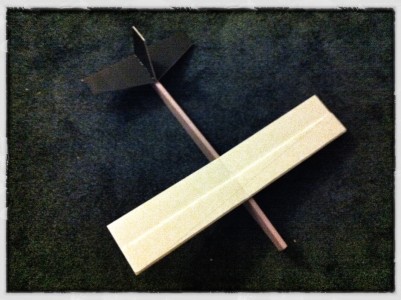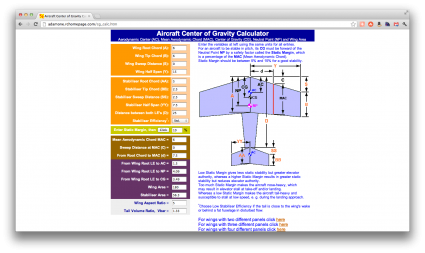New tail for my experimental trainer prototype…
Okay, yesterday I admitted that I could not do math. According to Sean Foster’s hints on trainer design, the horizontal stabilizer should have had an area of between 20 and 30 percent of the area of the main wing. My main wing is 30 inches with a six inch chord, so it has an area of 180 square inches. For some reason, I did the math wrong, and yesterday’s tail had an area of only about 27 square inches. Today, while watching Pablo Sandoval lead the Giants to a 1-0 lead over Detroit in the World Series (three home runs in his first three at bats? I love this game!) I decided to make a new tail with just about double the total area. I was out of white Dollar Tree foamboard, but I did have some black lying around, so I decided to give that a go. I started by cutting a 5×15 inch rectangle, and then tapering each side to 2.5″. That ends up with 56.25 square inches, which seemed pretty good. I made the vertical stabilizer out of a 5×5 inch square, which I then tapered to just 2.5″ at the top. I didn’t bother cutting in the rudder and elevator, because this was really just a model (which I might use as a glider test platform later, but not as an RC model).
The black foamboard doesn’t photograph well, but here’s the tail installed.
I think the proportions are more pleasing. In the real RC model, I’m thinking I’ll need to stiffen the main body, either by embedding struts, or doubling (or tripling) the body thickness. The balance of the glider is almost dead center now, well behind the wing, so it won’t fly as is. But I think it will probably fly pretty well once I get some more weight in the nose (in the RC version, it seems likely the motor, receiver, servos and batteries can compensate).
With some luck, I’ll get to a flight test this weekend.
Addendum: I tried to balance the plane by taping some weights to the nose and giving it a few practice tosses. Sean’s page suggested that the CG would be about 25-30% back from the leading edge of the wing, but when I adjusted the weight to balance, the plane was clearly nose heavy, and accelerated into a dive. Just before bed I plugged the numbers into a CG calculator, which suggested that with the spacing I chose, the CG should be better placed about 3.5″ from the leading edge (or about 60% of the way back). I’ll have to give that a try soon. But it’s time for bed.


I recall burning three or four weeks of a sabbatical getting Saccade.com on the air with Wordpress. So much tweaking…